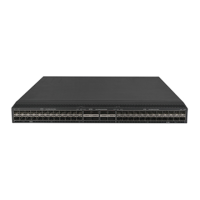32
For more information about BFD, see High Availability Configuration Guide.
Restrictions and guidelines
When you enable BFD for an aggregation group, follow these restrictions and guidelines:
• Make sure the source and destination IP addresses are reversed between the two ends of an
aggregate link. For example, if you execute
link-aggregation bfd ipv4 source
1.1.1.1 destination 2.2.2.2
at the local end, execute link-aggregation bfd
ipv4 source 2.2.2.2 destination 1.1.1.1
at the peer end. The source and
destination IP addresses cannot be the same.
• The BFD parameters configured on an aggregate interface take effect on all BFD sessions
established by the member ports in its aggregation group. BFD on a link aggregation supports
only control packet mode for session establishment and maintenance. The two ends of an
established BFD session can only operate in Asynchronous mode.
• As a best practice, do not configure BFD for any protocols on a BFD-enabled aggregate
interface.
• Make sure the number of member ports in a BFD-enabled aggregation group is less than or
identical to the number of BFD sessions supported by the device. If the aggregation group
contains more member ports than the supported sessions, some Selected ports might change
to the Unselected state.
• If the number of BFD sessions differs between the two ends of an aggregate link, check their
settings for inconsistency in the maximum number of Selected ports. You must make sure the
two ends have the same setting for the maximum number of Selected ports.
Procedure
1. Enter system view.
system-view
2. Enter aggregate interface view.
{ Enter Layer 2 aggregate interface view.
interface bridge-aggregation interface-number
{ Enter Layer 3 aggregate interface view.
interface route-aggregation interface-number
3. Enable BFD for the aggregation group.
link-aggregation bfd ipv4 source ip-address destination ip-address
By default, BFD is disabled for an aggregation group.
Display and maintenance commands for Ethernet
link aggregation
Execute display commands in any view and reset commands in user view.
Task Command
Display information about aggregate
interfaces.
display interface
[
{
bridge-aggregation
|
route-aggregation
}
[
interface-number ]
]
[
brief
[
description
|
down
]
]
Display the local system ID.
display lacp system-id
Display the global or group-specific
display link-aggregation load-sharing

